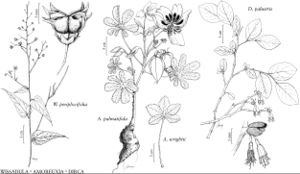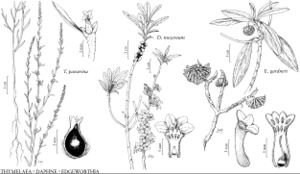Difference between revisions of "Thymelaeaceae"
FNA>Volume Importer |
FNA>Volume Importer |
Revision as of 23:46, 16 December 2019
Herbs or shrubs, deciduous or evergreen. Stems flexible; wood usually poorly lignified; bark ring; disc usually present (minute or absent in Thymelaea), surrounding gynoecium; stamens usually diplostemonous; anthers introrse, 4-sporangiate; ovary 1-locular, 1(–5)-carpellate; ovules 1+, pendent, raphe ventral, bitegmic, arillate or carunculate, anatropous or hemianatropous, crassinucellate; style 1, rarely absent, terminal or lateral; stigma capitate, clavate, or punctiform. Fruits capsular or drupaceous, usually fleshy, rarely dry, indehiscent [dehiscent]. Seeds 1[–8], usually with endosperm, testate; cotyledons 2, embryo achlorophyllous.
Distribution
North America, ne Mexico, s, c Europe, e, se Asia, n Africa, Australia.
Discussion
Genera ca. 46, species ca. 450 (4 genera, 7 species in the flora).
Classification of Thymelaeaceae within the dicotyledons is uncertain. It was placed in Myrtales, near Elaeagnaceae, because of its internal phloem and prominent hypanthium; that treatment is not supported by embryological and genetic data. Euphorbiaceae and Flacourtiaceae also have been suggested as possible relatives based on similarities in pollen and biochemistry. Other classifications place Thymelaeaceae in the Malvanae, either in its own order, Thymelaeales, or in Malvales.
All species are poisonous to mammals, containing tricyclic daphnane and tiglane diterpenes, esters of daphnetoxin, and coumarins. The bark and fruit can be extremely irritating to mucous membranes even after drying and cause contact dermatitis in sensitive individuals.
A dozen species of Daphne are grown for their sweet-scented flowers and early bloom. Species of Pimelea Banks ex Gaertner and Dais cotinifolia Linnaeus also are cultivated as ornamentals in warm climates.
Selected References
Lower Taxa
Illustrations
Key
| 1 | Herbs; leaf blades linear to linear-lanceolate, 0.6–1.5 cm; flowers 2–3 mm; fruits capsular, indehiscent. | Thymelaea |
| 1 | Shrubs; leaf blades ovate to obovate, oblong, elliptic, or lanceolate, 2–25 cm; flowers 1–18 mm; fruits drupaceous | > 2 |
| 2 | Stems appearing jointed; leaves scattered along stem, not clustered distally; stamens exserted. | Dirca |
| 3 | Styles short or absent; fruits fleshy, yellow, red or black, hypanthium not persistent. | Daphne |
| 3 | Styles linear; fruits dry to leathery, brown, enclosed at base by persistent hypanthium. | Edgeworthia |

